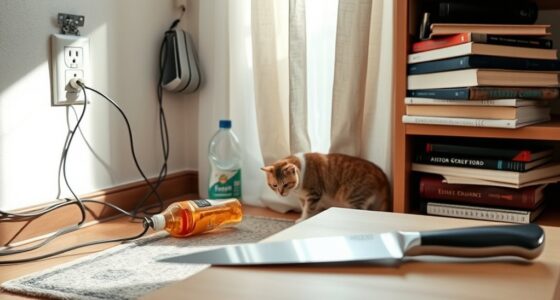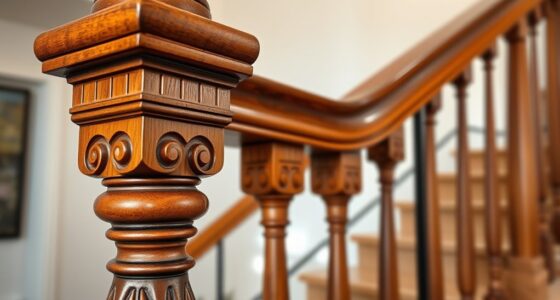Ensuring window and balcony safety in high-rise living means installing sturdy locks and security devices like smart locks and sensors, choosing tempered or laminated glass for railings, and regularly inspecting for damage. Keep safety alarms and barriers in place, secure furniture, and use weatherproofed enclosures to prevent falls and unauthorized access. Childproofing, proper maintenance, and emergency plans are essential. For tips on making your space safer, keep exploring to learn more effective strategies.
Key Takeaways
- Install sturdy, tempered glass railings and barriers that are securely anchored and regularly inspected for stability.
- Use window locks, safety alarms, and sensors to prevent accidental openings and alert residents to potential hazards.
- Keep windows and balcony doors locked when not in use and ensure proper maintenance to prevent damage or leaks.
- Childproof furniture, install window guards, and educate residents on balcony and window safety practices.
- Develop and regularly review emergency evacuation plans, including designated meeting points and building safety features.
Understanding High-Rise Window Safety Basics
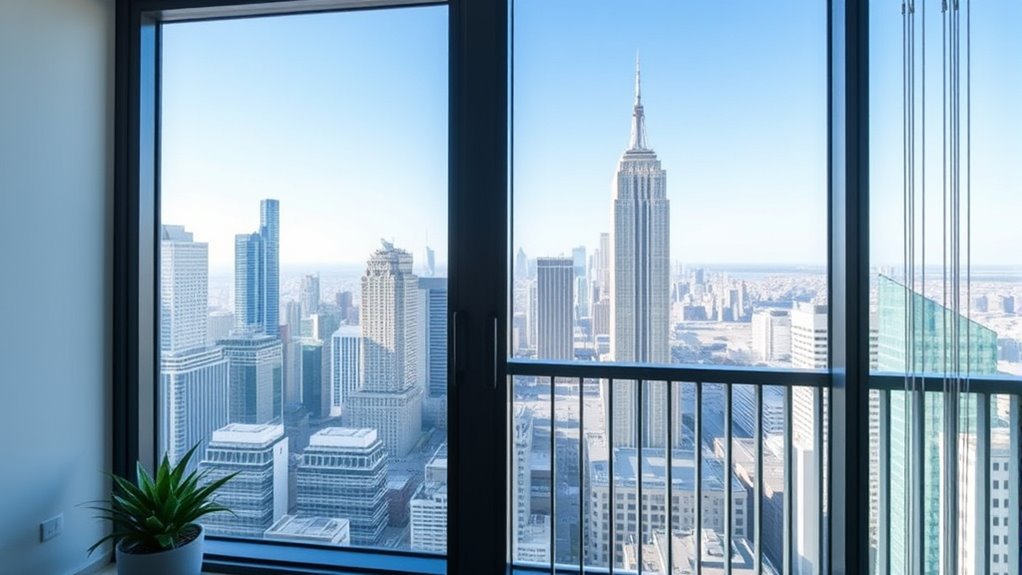
Understanding high-rise window safety basics is essential to prevent accidents and guarantee your well-being. Proper window tinting not only reduces glare and heat but also adds an extra layer of security by making glass less transparent and harder to break. Regular window cleaning keeps panes clear and free of debris, preventing buildup that can weaken glass over time. Always ensure your windows are properly maintained and inspected for cracks or damage. When opening windows, be mindful of their limits and avoid forcing them beyond safe points. Installing sturdy locks and safety devices further enhances security, but understanding how to handle your windows correctly is key. Staying vigilant about these safety basics helps you enjoy your high-rise home confidently and securely. Additionally, using proper cleaning techniques ensures that your windows remain in good condition and reduces the risk of damage or accidental breakage.
Choosing the Right Window Locks and Security Devices
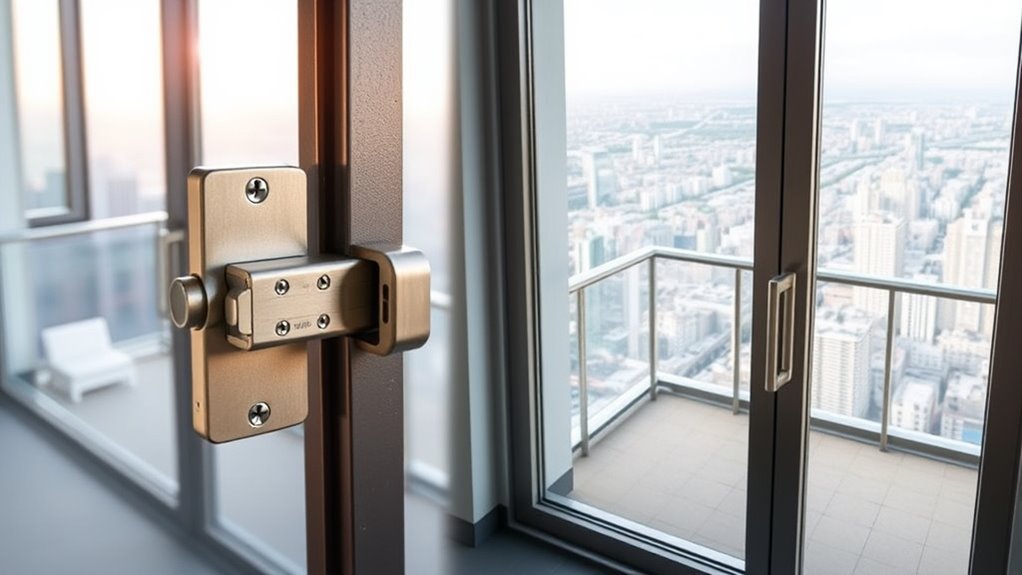
Choosing the right window locks and security devices is essential for protecting yourself and your home in a high-rise. You want solutions that prevent unauthorized access and alert you to potential dangers. Smart lock systems offer keyless entry, remote control, and activity logs, enhancing security and convenience. Sensor alarms detect movement or vibrations, providing immediate alerts if someone tries to tamper with your windows. To maximize safety, consider the following options:
| Device Type | Features |
|---|---|
| Smart Lock Systems | Remote access, activity monitoring, keyless entry |
| Sensor Alarms | Immediate alerts, tamper detection, easy integration |
Choosing the right combination helps secure your windows effectively, giving you peace of mind. Safety features and proper installation are crucial for optimal protection.
Installing Window Guards and Barriers
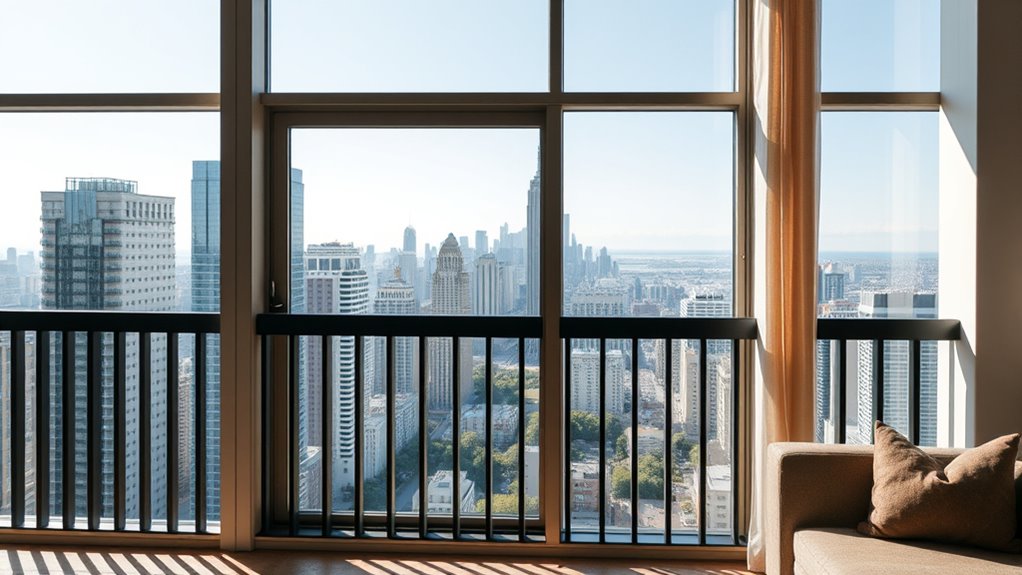
Installing window guards and barriers is one of the most effective ways to prevent falls and unauthorized access in high-rise living. These physical barriers provide peace of mind and protect children and pets from accidental falls. You can enhance safety further by applying window film, which deters breakage and adds an extra layer of security. Make sure your barriers are designed with emergency escape in mind, allowing quick exit if needed. Consider options like sturdy metal guards or reinforced barriers that blend safety with aesthetics. Keep in mind that proper installation is key to effectiveness. Regularly check that guards remain secure and undamaged. By combining window guards with strategic barriers, you considerably reduce risks and create a safer environment for everyone in your high-rise home. Additionally, understanding the importance of projector contrast ratio can help in assessing the overall safety and visibility of your home environment during power outages or emergencies.
Proper Maintenance and Inspection of Windows
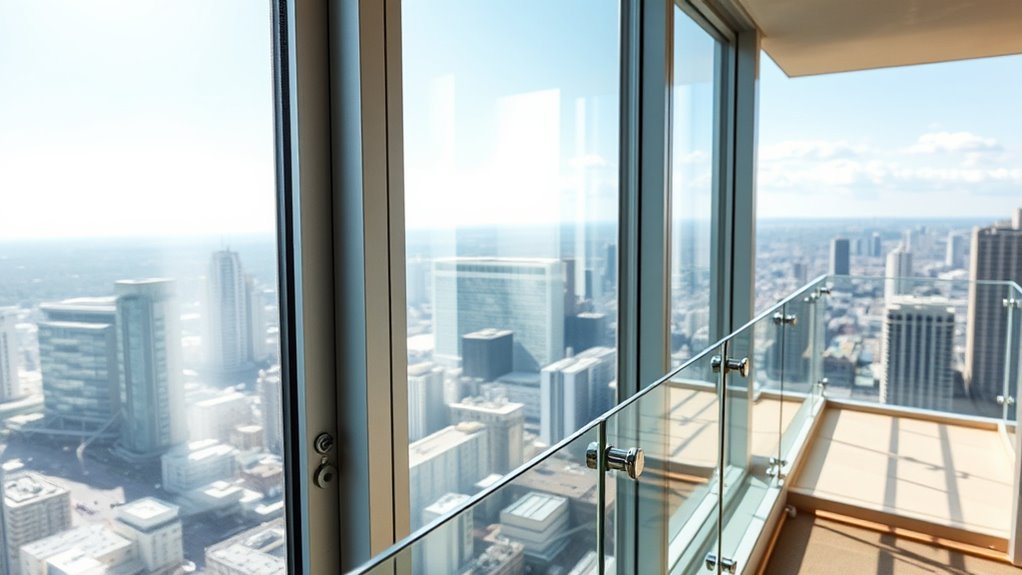
Regularly maintaining and inspecting your windows is essential to guarantee they function properly and remain secure. Start by cleaning your windows regularly; dirt and grime can hinder proper closure and obscure damage. During inspections, look for cracked or chipped glass, which may require glass replacement to prevent injury or further damage. Check the window frames and seals for signs of wear, warping, or leaks, and address issues promptly to maintain energy efficiency and safety. Ensure the locking mechanisms operate smoothly and securely. If you notice any damaged parts or compromised glass, don’t delay repairs—timely glass replacement or repairs help prevent accidents and enhance security. Staying proactive with window maintenance keeps your high-rise living safe, comfortable, and well-maintained. Proper maintenance and regular inspections are vital for ensuring your windows remain functional and secure over time.
Balcony Design Tips for Safety and Functionality
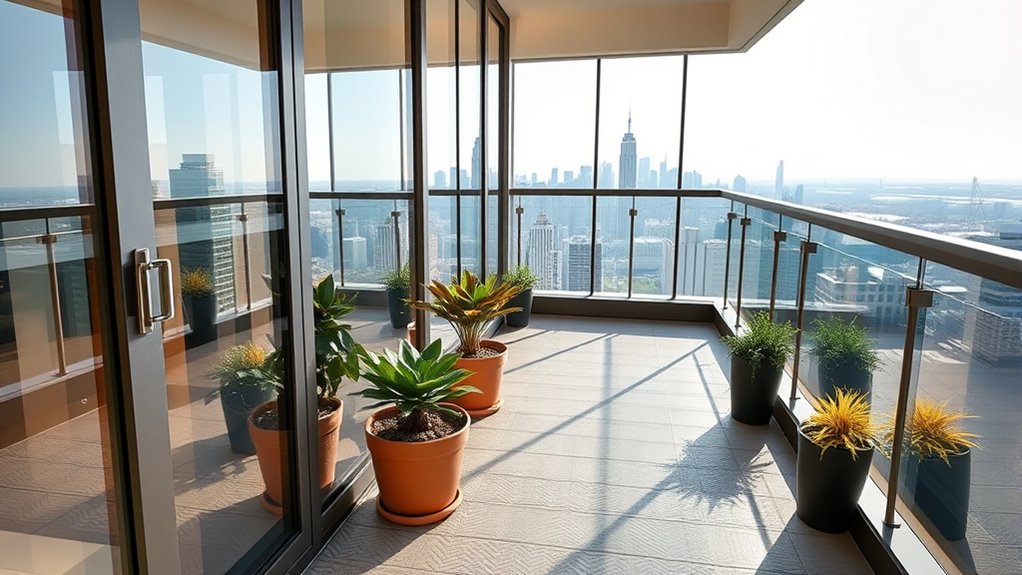
A well-designed balcony combines safety with functionality, ensuring you can enjoy outdoor space without compromising security. To enhance safety, consider glass enhancements like tempered or laminated glass for your railing and enclosure, which provide durability and clear views. Incorporate window aesthetics by choosing stylish frames that complement your building’s architecture and improve overall appearance. Additionally, selecting self-watering planters can help maintain healthy greenery with minimal effort, even in high-rise environments.
Key design tips include:
- Using transparent glass for unobstructed views while maintaining safety standards
- Installing sturdy, easy-to-clean railings that withstand weather conditions
- Integrating planters or furniture that don’t block pathways or compromise structural integrity
These adjustments balance safety with style, creating a balcony that’s both functional and appealing. Properly designed, your balcony becomes a secure, inviting outdoor retreat.
Securing Balcony Railings and Enclosures
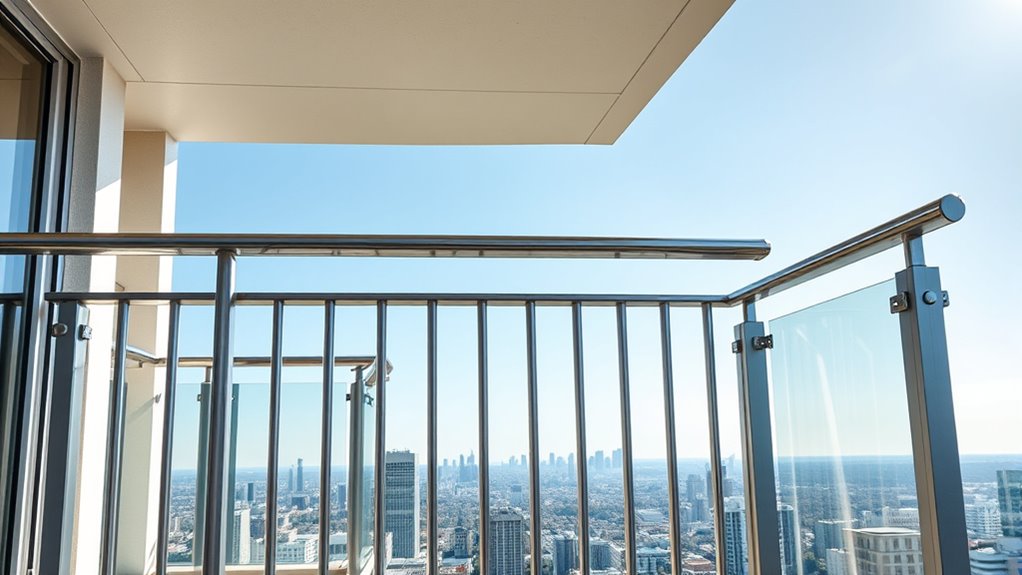
To make certain your balcony remains a safe space, securing the railings and enclosures is essential, especially in high-rise settings where the risk of accidents is higher. Start by inspecting your balcony railing for loose or damaged parts, tightening or replacing as needed. Consider adding weatherproofing solutions to protect the structure from rain, wind, and sun, which can weaken materials over time. For added balcony privacy, install transparent or decorative enclosures that also act as a barrier to prevent falls. Secure all panels tightly and ensure no gaps or weak spots exist. Properly maintained railings and enclosures not only enhance safety but also help preserve your balcony’s privacy and longevity, making it a more secure, private outdoor retreat.
Safe Practices When Using Windows and Balconies
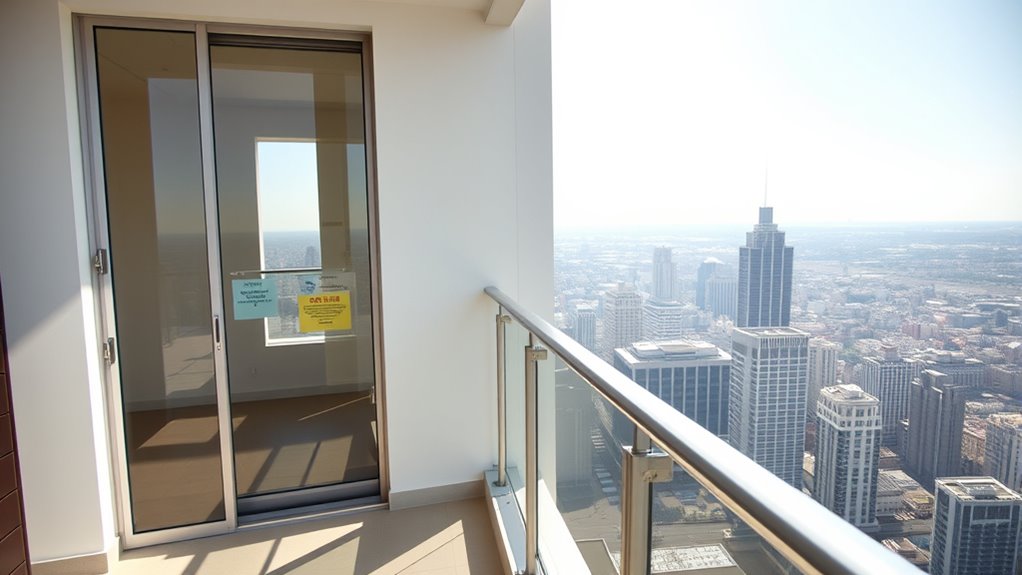
Ensuring your balcony railings and enclosures are secure is just the first step in maintaining a safe high-rise home. When using windows and balconies, stay vigilant to prevent accidents. Always supervise children around open windows or balcony doors, and avoid leaning or climbing on railings. For interior window treatments, choose cordless blinds or secure cords out of reach to prevent strangulation hazards. Regularly inspect window screens and locking mechanisms to guarantee they function properly. When cleaning windows, use safe techniques—avoid overreaching or using unstable equipment that could cause falls. Keep furniture or objects away from windows to prevent climbing or accidental falls. Remember, safe practices protect everyone in your home and help you enjoy your high-rise living space safely. Proper window safety measures can significantly reduce the risk of falls and injuries.
Emergency Preparedness and Rescue Plans
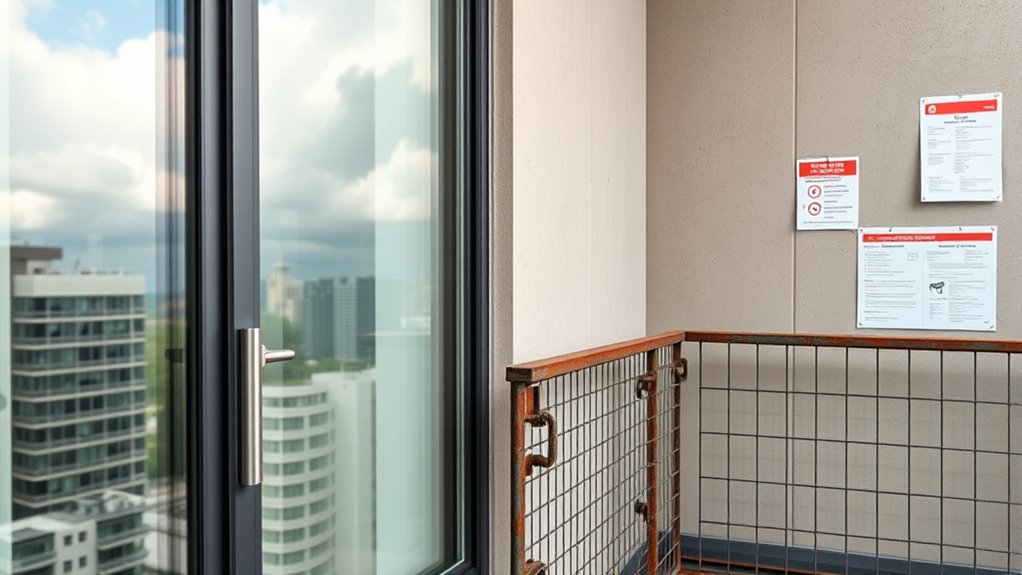
Because high-rise living presents unique safety challenges, it’s essential to have a clear emergency preparedness and rescue plan in place. You should familiarize yourself with designated fire escape routes and ensure they’re always accessible. Practice evacuating quickly and calmly, so you’re prepared if an emergency occurs. Keep emergency contact protocols updated and easily accessible, including numbers for fire, police, and building management. Make sure all household members know what to do and where to go during a crisis. Establish a meeting point outside the building in case you need to evacuate. Regularly review and update your safety plans, and coordinate with neighbors or building staff to ensure everyone understands the procedures. Being prepared can make all the difference in critical moments. Additionally, understanding building safety features can help you respond more effectively during an emergency.
Tips for Childproofing High-Rise Living Spaces
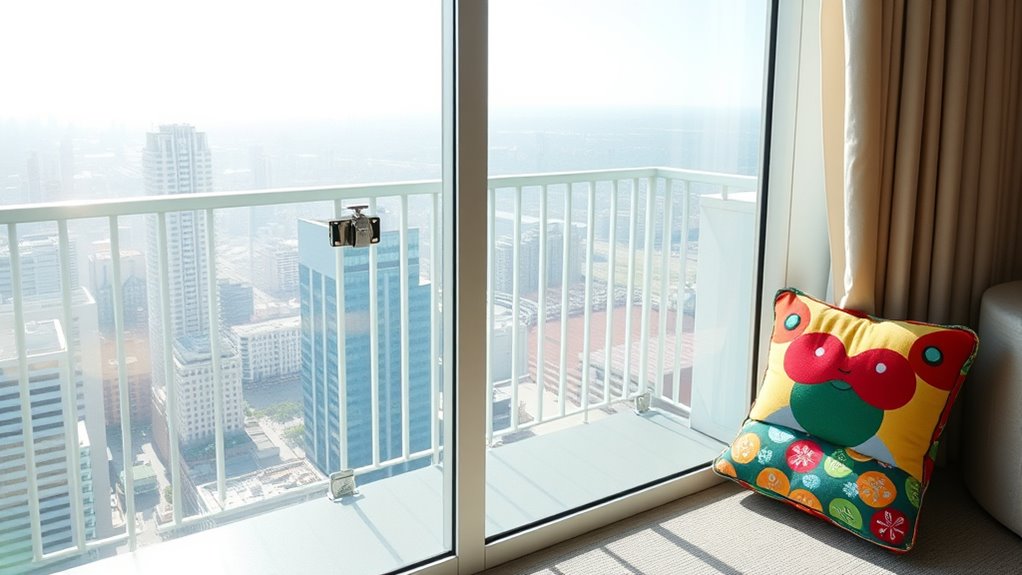
High-rise living offers unique safety challenges for families with children, making childproofing a top priority. To keep your little ones safe, focus on childproofing furniture to prevent tipping and climbing hazards. Install window safety alarms to alert you if a window opens unexpectedly, especially near balconies. Use safety locks on cabinets and drawers to keep dangerous items out of reach. Consider securing heavy furniture to the wall to prevent tipping. Keep windows and balcony doors locked when not in use. Regularly check that safety devices are functioning properly. Incorporating expert voice actors into safety education materials can help communicate these precautions more effectively. These steps help create a safer environment for your children and give you peace of mind in your high-rise home.
Frequently Asked Questions
How Do I Select Window Safety Devices Suitable for Different High-Rise Building Types?
When choosing window safety devices, you need to evaluate your building type and specific needs. Start by examining your windows and selecting appropriate window lock systems for security and child safety. Then, explore different window guard types, such as fixed guards or removable screens, to guarantee easy access and safety. Always opt for devices that are compatible with your window style and meet safety regulations, giving you peace of mind.
Are There Specific Regulations or Codes Governing Balcony Safety in High-Rise Residences?
You need to follow building height regulations and balcony inspection standards that govern balcony safety in high-rise residences. These regulations specify minimum safety features, guardrail heights, and inspection requirements to prevent accidents. It’s your responsibility to make certain your balcony complies with local codes, which often include regular inspections and maintenance. Staying updated on these standards helps you maintain a safe environment and avoid penalties or hazards related to balcony safety violations.
What Materials Are Best for Durable, Child-Safe Balcony Barriers?
When choosing materials for balcony barriers, you want durability and child safety. Shatterproof glass is an excellent option because it’s strong and resistant to breaking, preventing accidents. Additionally, opt for barriers with non-toxic coatings to guarantee safety if children touch or lick the surfaces. These materials provide long-lasting protection, giving you peace of mind while enjoying your high-rise residence. Always verify local regulations to meet safety standards.
How Can I Prevent Window and Balcony Hazards During Extreme Weather Conditions?
During extreme weather, you should prioritize storm preparedness and guarantee your windows and balcony barriers have high wind resistance. Secure loose items, close and lock windows tightly, and consider installing storm shutters or window films for extra protection. Regularly inspect your balcony barriers for stability, and avoid using them during severe conditions. Taking these steps helps prevent hazards and keeps you safe during storms or strong winds.
What Are Recommended Safety Practices for Pets Living in High-Rise Apartments?
Think of your pet as a tightrope walker—balance is vital. To keep them safe in high-rise apartments, always use pet restraint like harnesses or gates near windows and balconies. Provide indoor enrichment to keep their minds engaged and reduce the urge to explore dangerous areas. Regular training and supervision are essential, ensuring your furry friend stays secure and happy, even in the tallest of buildings.
Conclusion
Remember, your safety depends on staying vigilant and proactive. Regularly check your windows and balcony features, and never overlook small issues—they could become big hazards. Always have an emergency plan in place, but what if the unexpected happens when you least expect it? Stay alert, prepared, and committed to high-rise safety. After all, the true danger isn’t just in the fall, but in what you might overlook until it’s too late.


